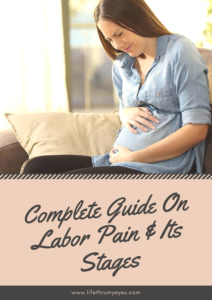The experience of each and every woman of Labor pains is quite different. You can start working only when the labor actually starts and you have been through it. The changes which take place in pre-labor, as well as early labor, can cause tell-tale symptoms and signs that labor is evident.

During the pre-labor or the early labor, you might have:
- Persistent pain in the lower back or abdomen with premenstrual cramps
- Painful tightening or contractions which may be quite irregular in frequency as well as strength and may start and stop
- Broken waters- the membrane may even rapture with a trickle of the amniotic fluid or a gush. Even though it may happen before the labor pains actually start, you still need to call the maternity unit
- A blood-tinged or brownish mucus discharge or blood show. In case you pass on the mucus plug which causes blockage in the cervix, labor pains may start soon or just in a couple of days, it is a sign that the things have started moving along
- Loose bowels or upset tummy
- A period of feeling excited, emotional or moody. You may even feel anxious, restless or impatient
- Disrupted sleep
First Stage of Labor pains
 The 1st stage comprises of active labor, early labor, and transitional labor. Early labor pains start when the cervix starts preparing for giving birth by shortening and thinning. It would even shift the position so that it is pointing towards the front, moving basically from the position that initially towards the back.
The 1st stage comprises of active labor, early labor, and transitional labor. Early labor pains start when the cervix starts preparing for giving birth by shortening and thinning. It would even shift the position so that it is pointing towards the front, moving basically from the position that initially towards the back.
Early stages of labor pains have 3 phases:
Latent
This is the stage of contraction and maybe just 20 mins apart as the cervix starts opening as well as widening to approximately 3cms.The contractions at the latent stage might not be quite prominent, feeling like menstrual pains or mild cramps. It is quite likely that you would be able to talk to them without any discomfort and you can easily continue with the routine work. It is however advised that you stay home during this stage till contractions become even more strong.
Active stage
During this stage of Labor pains, the contractions would start being more frequent and powerful. The cervix starts opening from 3 cms to a fully dilated 10 cms. Unlike latent stage, the contractions would now be more often, close to 3 to 4 minutes and they would last anywhere between 60-90 seconds.
As you start advancing through the active stage and the cervix starts dilating, the contractions would become stronger. You would find that you would not even be able to speak through each of these. Instead, you will have to focus on your breathing and the relaxation techniques for controlling your breathing. You may even lose your appetite and then start feeling sick at the active stage as your body first prepares itself for delivery of the baby by properly clearing out the digestive system.
At the active stage, you need to move to the place of birth or have the midwife come to you in case you are planning to give birth to your child at home.
Transitional stage
This stage happens when the cervix is approximately 8 cms dilated and it is also when the mother may have her first urge to push during her Labor pains. You might feel a bit shaky, cold and even sick and would perhaps feel like you cannot carry on. But you definitely can because at this time, the end is totally well and insight and you would be soon holding your baby in your arms.
The contractions may become less frequent but they would even be quite strong and long lasting every time. At this point, it might happen that you may need pain relief for helping you through.
Second Stage of Labor
The second stage of Labor pains begins when the baby makes his or her entrance into this world. You would be completely dilated which means that your cervix will be opened completely and you would be ready to start pushing the baby out. The midwife would help you find a comfortable position for delivering in. It may be kneeling, sitting or leaning over the birthing ball. This stage lasts between 5 mins to a few hours but if you have had a child earlier it is likely to consume less time.
With each and every contraction you would feel the head of the baby lower down in the pelvis. You may even feel an urge of bearing down and start pushing. Every time you have contractions and start pushing, the baby would move further down the pelvis and you would come to a step closer.
As the head of the child would start emerging towards the end, the midwife would encourage you for panting rather than pushing. Once the head of the baby is out, rest of his body would follow with next contractions.

Third Stage of labor
Now since you’re holding your child and having a beautiful skin on skin contact, you may think that it is over but there’s another final stage left- delivering the placenta.
You might get a couple of minutes for resting before the contractions begin again and you might feel an urge to again push since the placenta peels off from the walls of the uterus. Once the membranes and the placenta are out, the midwife would probably scrutinize it for ensuring that nothing is left behind. They would even scrutinize your stomach to check if your uterus has started contracting or not to stem bleeding from where the placenta is peeled off.
So, these are the stages of labor that you need to know if you are pregnant. Watch out for these signs and know if it is about time. Notify your spouse or a family member immediately and rush to a hospital for medical help. Be ready to welcome your little one in a few hours.
Also, Read- Pregnancy symptoms you should never ignore
If you have an interesting story of labor pain to share with us please do share in the comments section below. We would love to hear varied experiences and how beautifully you could tide through and dive into yet another beautiful phase of parenting.
For more on motherhood, follow along with Rakhi on Facebook | Instagram | Twitter
Love Deeply. Give Freely. Laugh Often.
PC- World wide web







This is such a well
Documented article that moms to be should read
This is a helpful guide. Wish I had read something like this while I was pregnant.
Wow!!! thank you for this detailed blog post. though i experienced only the latent when my water broke and doc advised for immediate C-Sec.
Allthatsmom
It is such an informative post. Every women should be aware of these symptoms.
That’s a very informative and detailed post. Will recommend it to my friend, she’s just finished her first trimester
Really valuable information for all women mom to be. Should know by all women so that they can prepare themselves for labour pain. Will share with others also.
A must read post for all the women.you have stated all the facts related to normal delivery.will definitely share it with friends
Great information for moms to be. It is good to know this so the panic and fear regarding labour pain can be controlled.
This is a very helpful guide. I knew nothing when I was pregnant, atleast this info will help a lot of moms like me who are totally clueless.
Must article a mother should read it… This helps alot
This is such an informative and detailed article for a parent to be. Labor is not easy, it is so hard and very hurtful. That’s why every women/pregnant aware of these symptoms.
This is so useful to so many women out there. Sharing it with a friend who’s pregnant.
These are extremely useful tips for moms-to-be..
That sounds really intimidating but definitely a very useful post
Kudos to you for sharing such an informative post 👍 It would help out many for sure
Must read for moms to be. Very informative post.
A great well researched post. I’m sure all expecting parents would benefit from this.
[…] Also, Read- Things you should know about labor pains-A complete guide […]
Great blog. This will going to helpful for all those who are going to give a birth.
[…] Also, Read-Complete guide on labor pains […]